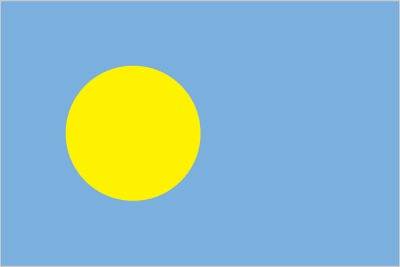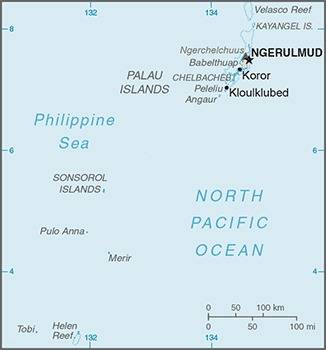47 Palau

Light blue with a large yellow disk shifted slightly to the hoist side. The blue color represents the ocean, the disk represents the moon. Palauans consider the full moon to be the optimum time for human activity. It is also considered a symbol of peace, love, and tranquility.
Flag courtesy of the CIA World Factbook

Map courtesy of the CIA World Factbook

The Peleliu War Museum is housed in a former Japanese storage bunker that was used during the Battle of Peleliu (15 September 1944 – 27 November 1944) as command post. The bunker was heavily damaged from the outside by artillery shells fired from the sea. The collection consists of many relics found on the battlefield, such as weapons, helmets, and personal belongings.
Photo courtesy of the CIA World Factbook
Government
According to Britannica, the constitution of the Republic of Palau established a presidential form of government, which was installed in 1981. The executive consists of the separately elected offices of president and vice president, the Council of Chiefs to advise the president on traditional laws and customs, and the cabinet. The Olbiil Era Kelulau (National Congress) consists of the Senate and the House of Delegates. Both executive and legislative branches are elected for four-year terms. Voting is open to individuals age 18 and older. The Palau judiciary consists of the Supreme Court, with both trial and appellate divisions, the Court of Common Pleas, and the Land Court. At the local level, each of the 16 traditional settlement areas constitutes a state with an elected governor and legislature.
Palau National Aviation Administration (PNAA)
The Palau National Aviation Administration (PNAA) was created by virtue of RPPL 5-19 establishing an administration in compliance with requirements of the International Civil Aviation Administration (ICAO) to regulate and oversight civil aviation safety and security of Palau’s Aviation Industry. The PNAA as the national civil aviation regulator and oversight authority in Palau is mandated to promulgate National Aviation Rules & Regulations and to adopt and implement ICAO’s Standards and Recommended Practices to be followed by airport, air carriers serving the Republic of Palau and any other aviation activities within Palau’s navigable airspace. Today, the PNAA has develop twenty (23) Civil Aviation Rules and Regulations and adopted additional aviation programs and documents consistent with various ICAO Standards.
Airspace
SkyVector – Google Maps – ADS-B Exchange
ICAO countries publish an Aeronautical Information Publication (AIP). This document is divided into three parts: General (GEN), En Route (ENR) and Aerodromes (AD). ENR 1.4 details the types of airspace classes they chose to adopt from classes A through G.
Drone Regulations
Currently, there is no legal framework for the use of drones.
In 2017 there were some public advisories but these are no longer on their website so there is no telling whether they are still current.
Advanced Air Mobility (AAM) Regulations & Policies
None found by the author.
However, should you, the reader, happen to stumble across something to the contrary, please email the author at FISHE5CA@erau.edu and you may be mentioned in the ACKNOWLEDGEMENTS section of this book by way of thanks for contributing to this free eBook!
Advanced Air Mobility (AAM) News
None found by the author.
However, should you, the reader, happen to stumble across something to the contrary, please email the author at FISHE5CA@erau.edu and you may be mentioned in the ACKNOWLEDGEMENTS section of this book by way of thanks for contributing to this free eBook!
Short Essay Questions
Scenario-Based Question
You have been hired by a Drone Startup Company. Your boss has immediately assigned this job to you.
They need you to prepare a one-page memo detailing the legalities of using a drone in Palau.
They need you to mention any national laws and local ordinances.
They specifically want to know what airspace (insert pictures) you will be operating in and whether or not you need an airspace authorization.
Does it matter whether or not you are a citizen of the country?
Lastly, there is a bonus for you if, as you scroll through this chapter, you find any typos or broken links!
Short Essay Questions
- What are the drone categories?
- How is registration addressed?
- How is remote ID addressed?
- What are the model aircraft rules?
- What are the commercial drone rules?
- Are there waivers or exemptions to the rules? If so, for what?
- Would you share a link to an interactive airspace map?
- How is BVLOS addressed?
- How can you fly drones at night?
- How can you fly drones over people?
- Where do you find drone NOTAMs?
- What are the rules for drone maintenance?
- What are the rules for an SMS program?
- What are some unique rules not mentioned above?
- What are the C-UAS rules?
- What are the AAM rules?

